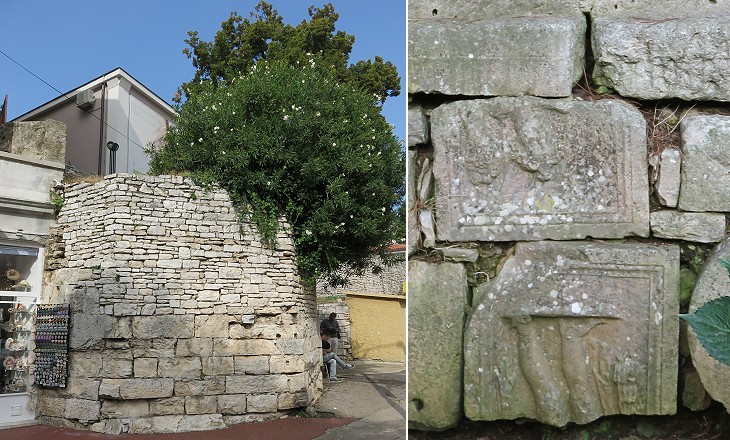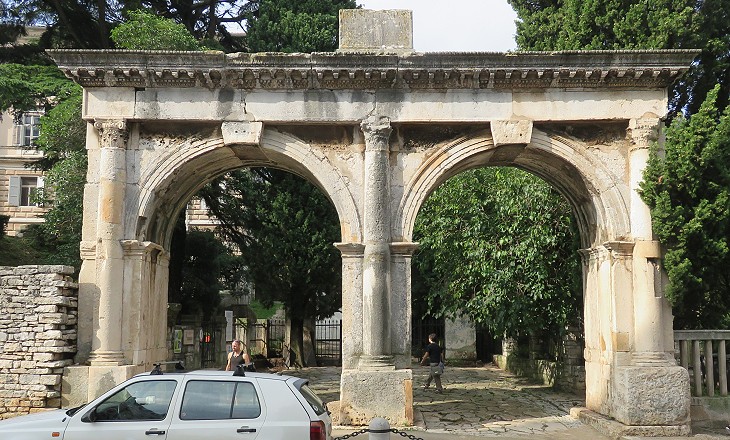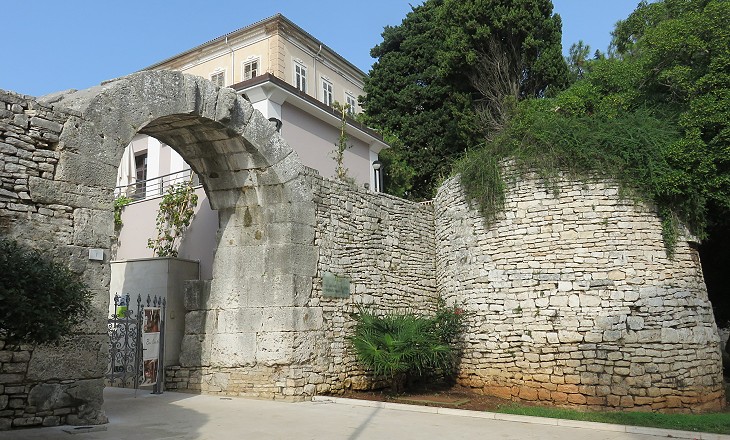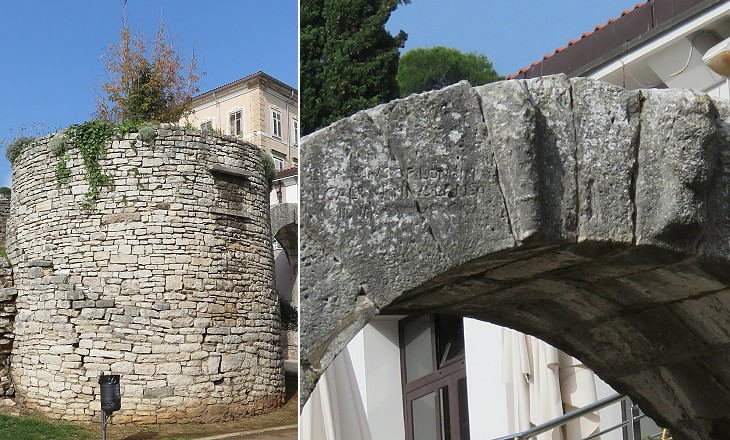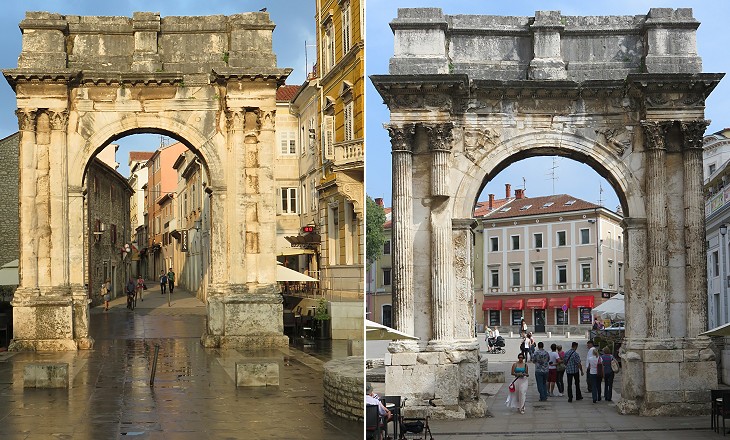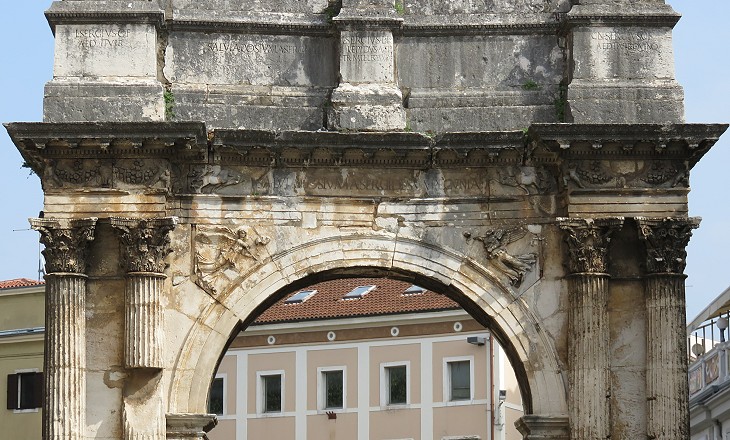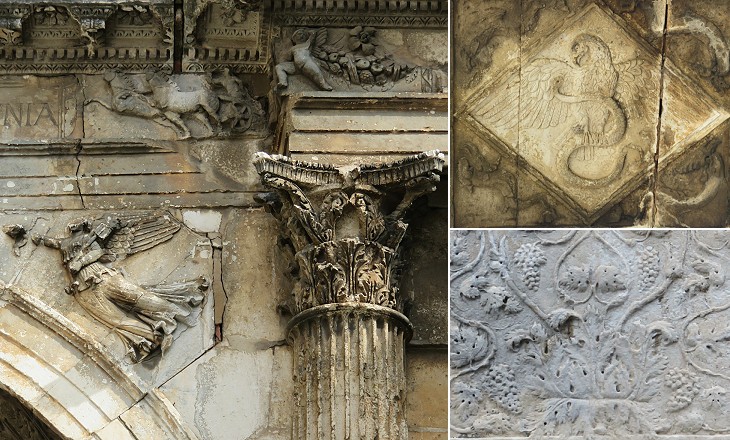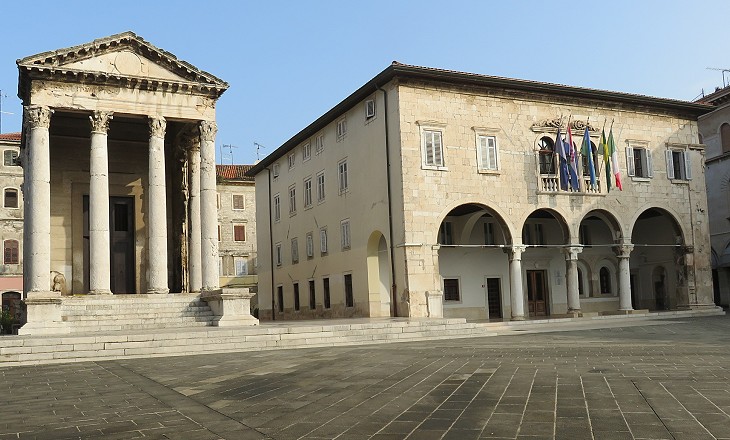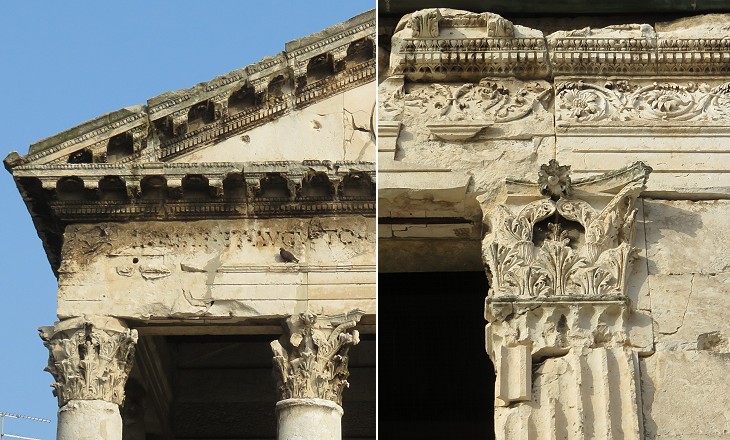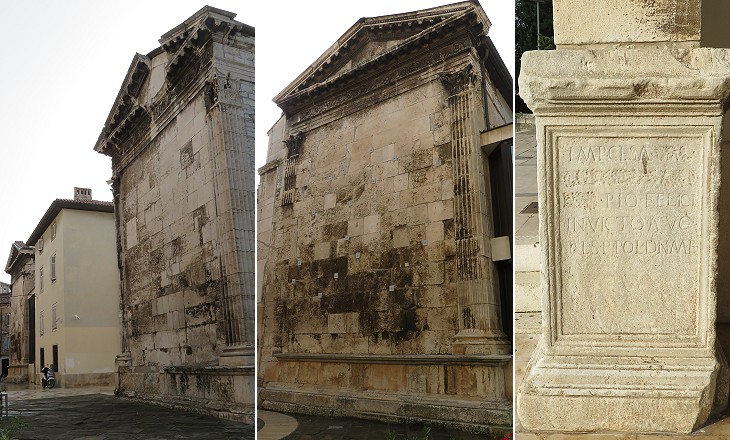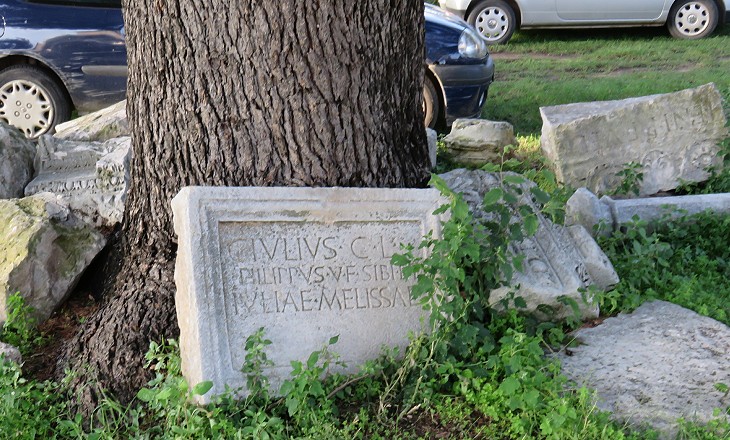  What's New! Detailed Sitemap All images © by Roberto Piperno, owner of the domain. Write to romapip@quipo.it. Text edited by Rosamie Moore. Page added in December 2014. |
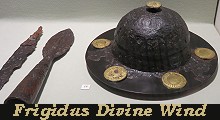 - Roman Pola (Pula) - page one - Roman Pola (Pula) - page one(Longobard weapons at Museo Archeologico di Cividale) You may wish to read an introduction to this section first.
In historic times Pola first appears as a Roman town. It is said to have been destroyed by Augustus on account of its adherence to the party of Brutus and Cassius, and it was re-founded by him under the name "Pietas Julia" as a monument of his reverence for the first Caesar, a colony of his soldiers being settled here on land taken from the older inhabitants. The situation of the town, which lay on the route from Ancona to Zara and the Roman settlements in the interior of Illyria and Pannonia, gave it considerable commercial consequence, and it grew and prospered. Its population has been estimated at from 25,000 to 30,000 and its flourishing condition under the Empire is attested by the magnificence of those ancient monuments that still remain. Sir Thomas Graham Jackson - Dalmatia, the Quarnero and Istria - 1887 Sir Thomas Graham Jackson (1835-1924) was one of the leading architects of his time. He visited Pola in 1885. Other excerpts of his book can be read in a section covering Diocletian's Dalmatia.
Behind the screen of new buildings the old Venetian town remains tolerably unaltered, a network of narrow alleys converging upon a tolerably spacious piazza, which partly occupies the site of the Roman Forum. Relics of Roman Pola, the Pietas Julia of Augustus, abound in every direction; of the two temples that fronted the upper end of the Forum, one is almost perfect, and the other has one end intact; the Corso leads directly to the old Porta Aurea and the arch of the Sergii, and a short walk thence round the outside of the old line of walls brings one to the Porta Herculea and the Porta Gemina. T. G. Jackson
Porta Gemina is a double-arched gateway which formerly admitted to the square interior of a bastion, beyond which a single archway opened to the town. The architecture is not remarkable, except for the omission of one of the three members of the entablature (the frieze). An inscription above it relates to the aqueducts by which the city was supplied with water. T. G. Jackson Porta Gemina (Twin Gate) was a decorative entrance to Pola and to one of its theatres. It was most likely built in the IInd century AD, when the wall enclosure had the mere purpose of marking the legal boundary of the town. A very similar gateway was built at Attalia (today's Antalya in Turkey) to celebrate Emperor Hadrian. The Venetians, in order to strengthen the defences of the town, closed Porta Gemina.
Following the circuit of the walls, a few steps bring one to another gate cut obliquely through the wall, which from the club and heroic head carved over it has been named the Porta Herculea. T. G. Jackson The size and position of the gate indicate that it was built together with the walls in the Ist century BC. The length of the walls was rather short because the Roman town stood on an almost circular hill, half of which projected into the sea. Per se the position was not particularly suited for a port, but Pola was situated in a drowned river valley with a narrow opening to the sea. A series of hills to its east partly sheltered the town from bora, the strong wind which blows over the region in winter.
The gate shows the strong links with Rome of the first settlers. Hercules was regarded as a sort of patron saint by the Romans: (Evander, a wise man) upon learning his name, his father, and his birth-place, exclaimed, “Hail, Hercules, son of Jupiter! You are he, of whom my mother, truthful interpreter of Heaven, foretold to me that you should be added to the number of the gods, and that an altar should be dedicated to you here (on the Palatine hill) which the nation one day to be the most powerful on earth should call the Greatest Altar, and should serve according to your rite.” Hercules gave him his hand, and declared that he accepted the omen, and would fulfil the prophecy by establishing and dedicating an altar. Then and there men took a choice victim from the herd, and for the first time made sacrifice to Hercules. Titus Livius (Livy) - The History of Rome - Book 1. Translation by Benjamin Oliver Foster.
Continuing the circuit of the walls westward from the Porta Herculea one arrives at the Porta Aurea, or rather its site, for the gateway itself has disappeared. There remains however a memorial arch of the family of the Sergii, which they were allowed to build against the town gate, and which has survived the gateway itself. On the outside may be seen the bonding stones of the two side walls of the square enclosure, which here, as at the Porta Gemina and at the two gateways remaining at Spalato, intervened between the outer archway or gateway proper and that opening into the town street. T. G. Jackson Today the link between Arco dei Sergii and Porta Aurea is not as easy to understand as it was when Jackson visited Pola, because the bonding stones of the walls between the two buildings have been removed. Porta Aurea was pulled down in 1829 to enhance the view of the arch. A painting by Charles-Louis Clérisseau (ca 1760) shows the arch and the gate (it opens in another window).
The real front of the arch consequently is inwards towards the town, and the outer side is plain and has its columns only partially finished. The arch was built, as the inscription tells us, in honour of three members of the Sergian family, whose statues no doubt occupied the three pedestals of the attic. As no emperor is named in the inscriptions the date of the monument is uncertain. T. G. Jackson Today the arch is dated late Ist century BC. This because one of the members of the Sergian family to whom the arch was dedicated held a position in the XXIXth Legion. This Legion was raised by Julius Caesar in 49 BC and disbanded by Augustus after his victory over Mark Antony and Cleopatra at Actium in 31 BC.
The proportions are rather wide and the scale is not great, but the design is good, and the arabesque ornamentation pretty, though like all Roman work of that kind far inferior to the similar work of the early Italian Renaissance. T. G. Jackson An eagle killing a snake is a subject which is often found in Christian iconography as a symbol of Good/True Faith killing Evil/Heresy, but its origin goes back to the ancient beliefs. The eagle was the symbol of Zeus/Jupiter and snakes had often (but not always) a negative connotation. A relief portraying an eagle carrying Emperor Titus to Heaven, can be seen in the arch dedicated to him in Rome in the same position as that shown above.
From the Porta Aurea the Corso or High Street runs to the Piazza, which occupies part of the ancient Forum. At the upper end of this stood and still stand two Roman temples, once exactly alike, though that to the right hand, dedicated according to tradition to Diana, can no longer be recognised by the front view as an ancient building at all. Between 1275 and 1300 it was enclosed within the walls of the Venetian Palazzo Comunale, and even of this palace only the side wall now remains, the front having fallen and been rebuilt in 1651. T. G. Jackson When Jackson visited Pola the Temple and the Town Hall were united by a series of small buildings which were pulled down in the 1920s as shown in an etching based on a painting by Charles-Louis Clérisseau (it opens in another window).
The other temple is almost perfect, and though not large, is as beautiful an example of Roman architecture at its best as any that has come down to us. The proportion is narrow and lofty; four columns of beautiful breccia support Corinthian capitals, which together with the ornaments of the entablature are executed with the utmost delicacy and finish. On the frieze was an inscription in raised letters of bronze which have disappeared dedicatory of the temple to Augustus, conjointly, as he always insisted, with Rome. T. G. Jackson Temples to Augustus and Rome have been found in many locations including Athens and today's Ankara.
In 1944 the Temple to Augustus was hit by a bomb and part of the dedicatory inscription was lost. The temple was studied by Andrea Palladio which included a drawing of it and details of its decoration (it opens in another window) in his 1570 treatise on architecture. In 1756 Count Francesco Algarotti, a Venetian philosopher and art collector, visited Pola and bought a fallen fragment of the Corinthian decoration of the temple. He eventually donated it to Pope Benedict XIV for the collections of Musei Capitolini. The Roman curators of the museum however were not very impressed by the gift which was not listed in the 1782 catalogue of the exhibits.
From the street behind it the back of this temple may be seen in a state of perfect preservation, corresponding in every detail with that of the sister temple, and standing in a line with it. T. G. Jackson The citizens of Pola had to hurry to erase the name of co-emperor Licinius from the inscription of a statue they dedicated to him before 317 AD when a war erupted between him and Constantine. He was defeated and had to surrender some territories he ruled which included Pola. In 324 at the end of a second war he was forced to retire as a private citizen to Thessalonica where he was executed in the following year. The formula Pio Felici Invicto (pious happy unbeaten) was first used in the IIIrd century AD and it appears in Roman monuments dedicated to Constantine.
(The Temple) now serves as a museum, though its small area is wholly inadequate to the proper display of the objects collected there, with which indeed the yard outside is almost as crowded as the museum itself. Modern Pola has surely equal claims with Spalato or Aquileja for a convenient building in which to display her collection. At present, statues, altars, inscriptions and sarcophagi are heaped up like materials in a mason's yard outside, and piled on the top of one another inside the building, so that it is often impossible even to see, much less to study, the object that most concerns one. There is no catalogue, nor would one be of any use unless the objects were better arranged and sorted; for at present Roman, Byzantine and mediaeval work is all mixed up in one general and hopeless jumble. T. G. Jackson A museum was opened in the 1920s near Porta Gemina, but in April 2013 it was closed for adaptation. It was still closed in September 2014, without a notice indicating the time of its reopening. A number of ancient inscriptions, columns, lintels. etc of the Roman and Venetian periods lie in a parking lot mixed up in one general and hopeless jumble. The image used as background for this page shows the funerary inscription of Sebia, aged twelve, in the parking lot. Go to Roman Pola - page two: The Amphitheatre and other Monuments or see its churches or its Venetian monuments or move to: Introductory page Roman Aquileia - Main Monuments Roman Aquileia - Tombs and Mosaics Early Christian Aquileia Medieval Aquileia Chioggia: Living on the Lagoon Chioggia: Churches Chioggia: Other Monuments Roman and Medieval Cividale del Friuli Venetian Cividale del Friuli Grado Palmanova Roman and Byzantine Parenzo (Porec) Medieval and Venetian Parenzo (Porec) Pomposa Roman Ravenna Ostrogothic Ravenna Byzantine Ravenna: S. Apollinare in Classe Byzantine Ravenna: S. Vitale Byzantine Ravenna: Other Monuments Medieval Ravenna Venetian and Papal Ravenna: Walls and Gates Venetian and Papal Ravenna: Churches Venetian and Papal Ravenna: Other Monuments Rovigno (Rovinj) Roman and Medieval Trieste Modern Trieste  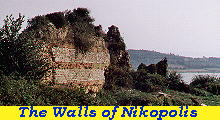 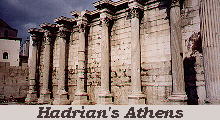 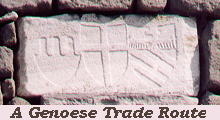 |
